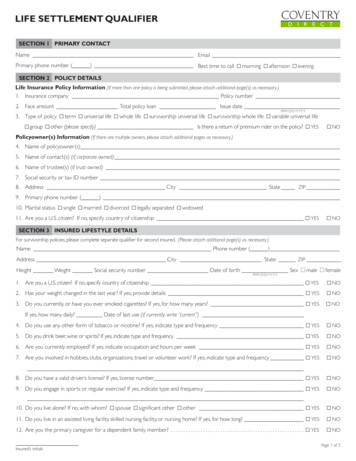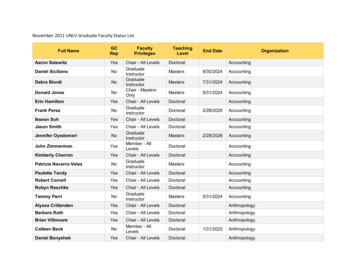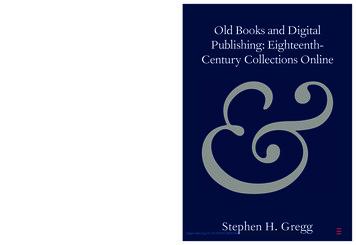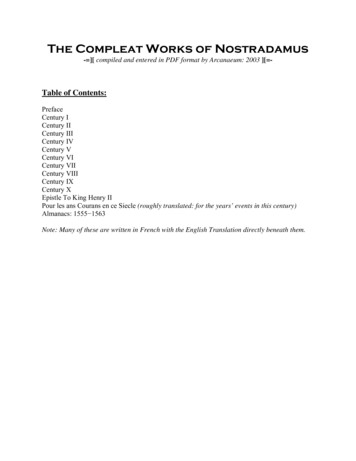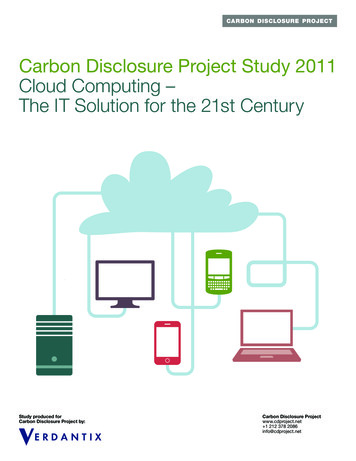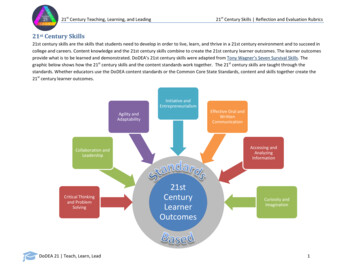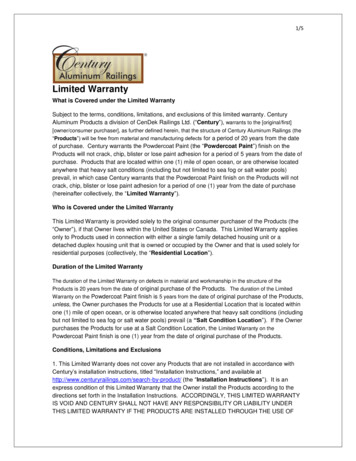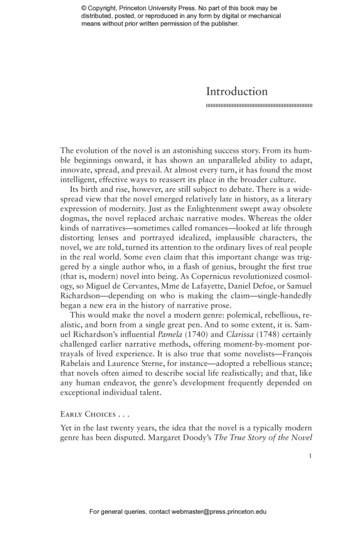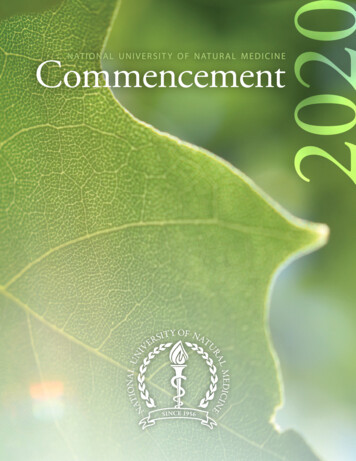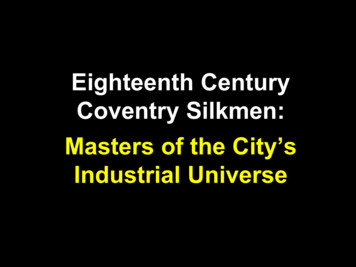
Transcription
Eighteenth CenturyCoventry Silkmen:Masters of the City’sIndustrial Universe
Some issues to be tackled Why silk ribbon weaving came to Coventry Who were Coventry’s silkmen? What did they do? What status did they have in the city? Can Coventry’s eighteenth century ribbon trade ofthe count as the start of its Industrial Revolution?
Why did a silk ribbon industry begin in Coventry? A tradition of textile production since the medieval period A relatively poor unemployed population who could easilyaccommodate and master a single hand loom A sufficient distance from London to have much lowerlabour costs, but near enough for transport not to be amajor problem to its main market because A light, high value product that could be easily transportedby road in the absence of water transport (like watches!) A significant non-conformist business class with readyaccess to capital
The most prominent example of the ‘Who’:The Bird Family(everyone a silkman except Richard the father/grandfather)Richardd. 1681SamuelWilliamJohnd. 1690d. 1731d. 1702RichardRobertThomasJohnd. 1725d. 1729d. 1746d. 1771
The most prominent example of the ‘Who’:The Bird Family(everyone a silkman except Samuel the father/grandfather)Richardd. 1681SamuelWilliamJohnd. 1690d. 1731d. 1702RichardRobertThomasJohnd. 1725d. 1729d. 1746d. 1771
The most prominent example of the ‘Who’:The Bird Family(everyone a silkman except Samuel the father/grandfather)Richardd. 1681SamuelWilliamJohnd. 1690d. 1731d. 1702RichardRobertThomasJohnd. 1725d. 1729d. 1746d. 1771
‘What’ silkmen doMerchants who firstly buy raw silk in London where it isimported and arrange for the silk to be ‘thrown’ intothreads and transported to CoventryThey hire undertakers to distribute it to weavers homeswho make it into ribbonsMost Coventry silkmen had warehouses in Coventry andin the Spitalfields area of LondonThere would not be more than a dozen at any one timein Coventry often a lot fewerSilkman apprenticeships were more exclusive thanbanking – cost up to 200 ( 20,000)They operated on lines of credit that could last for morethan a year
What thehistory bookstell us aboutthe 18th centuryribbon trade
Key facts common to mosthistorical accounts The trade was introduced by a mayor of Coventry in theearly 18th century He employed a number of Huguenot silk weavers whohad recently escaped persecution in France In 1746 a Coventry silk manufacturer employed 2000weavers Coventry became the ribbon-weaving centre of the UKafter the Spitalfields Act of 1773 forced silk productionout of the capital and into the provinces.
The most recenthistory of the Coventryribbon tradepublished in 2007 byThe Herbert
Who started it?The Thomas Bird Tendency Thomas Bird at the turn of the eighteenth century. “It seems likelythat he that he employed a number of Huguenot refugees”(History of Coventry Textiles, Alice Lynes, 1952, Chief CoventryLibrarian) Thomas Bird, 1703 “set up the first recorded silk ribbon weavingestablishment”(Silken Weave, Jenny Dodge, The Herbert, 2007)
Who started it?The William Bird TendencyWilliam Bird at the turn of the eighteenth century “who issupposed to have been assisted in its first establishment bysome of the French refugees” (1840 ParliamentaryCommission on Handloom Weavers)William Bird, “who manufactured ribbons in Coventry in1701”“In bygone days a strong facial resemblance could befound in many silk-weaving families to the people of southeastern France.The family names of the district are reminiscent of France”(The Silk Industry, Sir Frank Warner, 1929)
The Bird FamilyRichardd. 1681SamuelWilliamJohnd. 1690d. 1731d. 1702RichardThomasRobertJohnd. 1725d. 1746d. 1729d. 1771
The Bird FamilyRichardd. 1681SamuelWilliamJohnd. 1690d. 1731d. 1702RichardThomasRobertJohnd. 1725d. 1746d. 1729d. 1771
Why can’t anybody agree on exactly when theindustry started and by whom? Poorly referenced secondary sources repeating earlierpublications/traditions Plenty of contemporary references to silk but hardly anyspecific reference to ribbons – important because traditionalbroadlooms were very different to single hand looms used toweave ribbons. There is evidence for limited use of the formerin 17th century Coventry Few contemporary commentaries as no local newspapers until1741 (Jopson’s Coventry Mercury) and no surviving businessrecords for any ribbon firms
Here is one of the firstcontemporary writers to refer toribbons in Coventry –Daniel Defoe in the early 1720s “Coventry is a large and populous city, and drives a very greattrade; the manufacture of tammies (a fine cloth made of mixedtextiles for lining coats) is their chief employ, and next to thatweaving of ribbons of the neatest kind, chiefly black”(as noted in Volume 2 of the Warwickshire VCH) What Defoe actually wrote: “Coventry is a large and populous city, and drives a very greattrade; the manufacture of tammies (a fine cloth made of mixedtextiles for lining coats) is their chief employ, and next to thatweaving of ribbons of the meanest kind, chiefly black””
Here is one of the firstcontemporary writers to refer toribbons in Coventry –Daniel Defoe in the early 1720s “Coventry is a large and populous city, and drives a very greattrade; the manufacture of tammies (a fine cloth made of mixedtextiles for lining coats) is their chief employ, and next to thatweaving of ribbons of the neatest kind, chiefly black”(as noted in Volume 2 of the Warwickshire VCH) What Defoe actually wrote: “Coventry is a large and populous city, and drives a very greattrade; the manufacture of tammies (a fine cloth made of mixedtextiles for lining coats) is their chief employ, and next to thatweaving of ribbons of the meanest kind, chiefly black””
Evidence from St Michael’s ChurchRegister of Burials 1705-7 Of 300 burials silk weaver recorded 32 times andweaver (assumed to be wool trade) only 19 times Remarkable given the dominance of the wool trade over theprevious centuries and its supposed prominence still in the 1720s Surely it indicates a greater prominence for silk woven productsat this time, probably ribbons?
But perhaps the confusion is notso surprising when we have towait until 1761 for the firstsurviving evidence of an actualCoventry ribbon
From the HerbertCollection A Coventry ribboncommemorating the Coronation ofKing George III 1761 It’s a ‘figured’ ribbon (i.e.patterned not plain) which couldonly be woven one ribbon at atime unlike plain ribbons (easilyproduced by now eight or more ata time on an ‘engine loom) An advanced product that alsoincludes silvered metal thread
More Coventry silkman evidence fromthe V&A via the USA(The Winterthur Museum & Library Delaware)
What the de BrissacAccount Book tells us de Brissac’s account book refers to a number of his ribbonpatterns that he sold to a Mr. J Bird of Coventry one of these ribbons was a commemorative one:"to a pattern for a riband, a dove with an olive branch andthe words Peace and Plenty in a Lawrel reath". This presumably dates this entry in the account book for1762 to the end of the Seven Years War (1756-1763)
“To a pattern for a riband, a dove with a olive branchand the words Peace and Plenty in a Lawrel Reath".
But there is also another pagefrom de Brissac’s account bookfor a whole range of designsfrom 1761 – 1762 for ‘Mr Bird’It is proof of the commissioningof complex designs and of thecontinuing importance of theBird family in Coventry and itslinks to the Spitalfield silk tradeNB The maths does not looktoo good, but even at 10.10s( 1,050) this is an expensiveinvestment by Bird
The Bird FamilyRichardd. 1681SamuelWilliamJohnd. 1690d. 1731d. 1702RichardThomasRobertJohnd. 1725d. 1746d. 1729d. 1771
The Wealth of Non-Bird SilkmenIt is too easy to get caught up in the story of the prominentBird family and forget the other Coventry silkmen – all wealthyindividuals. But the city could only support the activities of afew such merchants at any one timeThere were only 23 silkmen who left wills at the PrerogativeCourt of Canterbury and 12 at the Diocese of Lichfield &Coventry over the whole of the eighteenth century almost 10of the former are accounted for by various generations of theBird family
Apart from wills there is other evidence ofsilkman wealth1728 Thomas Pool sentenced to death and his brother totransportation for robbing Mr Birch’s Coventry warehouse of 1500 ( 150,000) of ribbonsStamford Mercury 29 August 1728When Birch father died two years earlier he left all hisproperty to his eldest son but also gave 1000 ( 100,000) tohis married daughter and 4000 ( 400,000) to his unmarrieddaughter
In September 1762 ‘In the night between Monday andTuesday last the warehouse of Messrs Sherwood, Abneyand Reynolds, silkmen of this city were broke open (byforcing one of the pins in the bar that went across theinside window shut) and out of a desk therein, whichwas likewise broke open, upwards of 90 ( 9,000) incash was taken’Coventry Mercury 27 September 1762
How wealthy were the Bird Family?
The Bird PatriarchWilliam died in 1731 having already passed on much ofhis wealth to his eldest son, Richard, who pre-deceasedhim in 1725 but then passed the wealth out of theimmediate family.Even so William’s will contained a number of bequestsfor one or two thousand pounds ( 100,000/ 200,00)and his remaining properties to his son Thomas
The Bird PatriarchReferences in other wills gives some idea of the propertyWilliam had already amassed and passed onto his eldestson Richard before 1711e.g. The premises in High Street, near Broadgate Lands in Exhall, Foleshill and Keresley including themanor of Newlands The Horseshoe Inn at Spon End with severaltenements and lands there The house in Little Park Street originally occupied byLady Bridgeman
Bridgeman’s House, Little Park Street, Coventry:Built 1610, Demolished 1817
The Bird FamilyRichardd. 1681SamuelWilliamJohnd. 1690d. 1731d. 1702RichardThomasRobertd. 1725d. 1746d. 1729Johnd. 1771
The short lived Bird PatriarchRichard died in 1725“I give and devise my messuage in Little Park Street where I now live”
16, Little Park Street, Coventry Built c1725 by Richard Bird
The Bird FamilyRichardd. 1681SamuelWilliamJohnd. 1690d. 1731d. 1702RichardThomasRobertd. 1725d. 1746d. 1729Johnd. 1771
The most historically valuable Bird PatriarchThomas’s death in January 1746 gives us a rare, personal lookat what life was like for Coventry’s most prominent silkman;- partly from a newspaper comment- partly from his gravestone in Stoke parish church- but mainly from his detailed will
The valuable Bird PatriarchHe needed his status to be confirmed with a coat of arms:The search has revealed the record copy of the original grant ofarms to Thomas Bird in 1742.This shows that his family had long borne arms blazoned: A CrossFlory between four Martlets , but without the College’s authority;he and his descendants were therefore granted a version of thesearms with suitable differences. The genuine blazon of these newarms differs slightly from the description of those on his tomb; itis: Argent a Cross Flory Vert between four Martlets Gules a Chiefdovetailed Azure , while the crest is blazoned: On a Wreath of theColours A Greyhound’s Head Vert erased Gules collareddovetailed Or .Adam Tuck, College of Arms 2019
The next Bird Patriarch"On Monday last died at his house in this city,Thomas Bird, Esquire, one of the most eminentsilk manufacturers in England, in which branchof business he daily employed over two thousandworkpeople."Jopson’s Coventry Mercury of 13 January 1746
Silkman Wealth: Thomas Bird’s Will - 1“I give and devise my own dwelling house, lately erectedwith the warehouses and appurtenances thereto belongingin Little Park Street in the said city of Coventry and mycoach house and stable in the said street with theappurtenances and all my real estate whatsoever withinthe said city unto my said son Henry Bird his heirs”
7, Little ParkStreet,CoventryBuilt c1735 byThomas Bird
Three Bird houses all in the same streetIn eighteenth century Coventry it was claimed that. . .“The bulk of the better class houses, however, wereerected in Little Park Street, where, in spacious buildingsfar removed from the main roads, with their numerousinns and noisy coach traffic, the Caves, Stratfords,Bridgemans, Birds, and others took their pleasure;walked in the prim gardens attached to their residences”The Parliamentary Representation of the City of Coventry fromthe Earliest Times to the Present Date (1894) T.W. Whitley
Silkman Wealth: Thomas Bird’s Will - 2“Whereas I lately purchased the inheritance of anestate at Barton on the Heath in the said county ofWarwick late belonging to Thomas Overbury esquire,deceased for the sum of 13,000 ( 1,300,000) andupwards”
Barton on the HeathManor House
Silkman Wealth: Thomas Bird’s Will - 3“ my freehold messauages and lands with theappurtenances in Stoke in the County of the said city ofCoventry and the impropriate tyths of Stoke aforesaid andall other my real estate there which premises I purchased ofGilbert Malcher and others to my said eldest son RobertBird for and during the term of his material life.”
Silkman Wealth: Thomas Bird’s Will - 4Six gifts of sums ranging from 3,700 ( 370,000)to 5,500 ( 550,00) for his sons and daughters
Silkman Wealth: Thomas Bird’s Will - 5“ that is to say those which shall be then employed in mywarehouse in Coventry ten pounds a piece and those whichshall then be employed in my warehouse in London thirtypounds to be equally divided between them”
The London Connection
18th Century London Directories1768 John Bird Jnr Silkman1 Wood Street1802 William Wilberforce Bird Esq M P,Wood Street Cheapside
Wood StreetCheapside, London
Wood Street, Cheapside
Wood StreetSpitalfields, London
Wood Street(now known as Wilkes Street),Spitalfields
Wood Street interior,Spitalfields
What happened to the silkmen? References to Coventry silkmen tail off from the beginningof the nineteenth century Some London silkmen set up warehouses in Coventry anddeal directly with the undertakers After the disruption of the Napoleonic Wars a class of halfpay apprentices had appeared who could be exploited inworkshops separate from the home. Workshop operators could also deal directly with London,developing into the factory operations by the 1840s
So does this 18th century activity add up to anIndustrial Revolution in Coventry?For Coventry population 1694 6,7101801 22,801 with ribbon trade employing most Urbanisation filled up space within the old walled cityAgainst Almost all production based on full time weavers in their own homes– a simple extension on the city’s medieval craft based working All hand powered, no use of water or steam power No new technology beyond the introduction in 1760s of the engineloom (capable of producing multiple ribbons)
The End
Commission on Handloom Weavers) William Bird, who manufactured ribbons in Coventry in 1701 In bygone days a strong facial resemblance could be found in many silk-weaving families to the people of south-eastern France. The family names of the district are reminiscent of France _ (The Silk Industry, Sir Frank Warner, 1929) Who started it?
